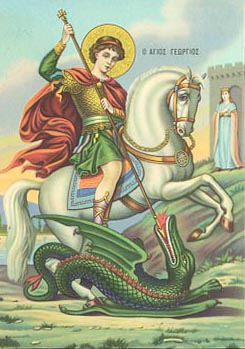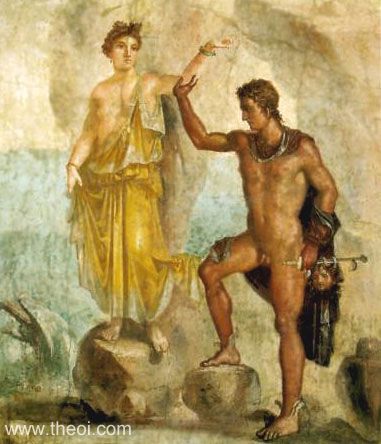 |
| St George and the Dragon Tintoretto 1555-58 National Gallery, London image Web Museum |
St. George is also a truly remarkable example of cultural persistence on one hand and of the process of reinterpretation of ancient heritage in changing times within a culture or civilization.
The home of the story is Joppe and the villain is a sea monster. Sounds familiar?
Greec Orthodox Iconic representation
 |
| Standard iconic representation Image mysterygirl |
The icon usually has the following basic elements
- Saint George as a robed knight riding a mighty horse in the act of killing the dragon using his spear
- A fearsome dragon at the foot of the victor's horse
- A building in the background
- A woman standing in front of the building
There are many modifications and embellishments to the basic themes. I have noticed that for reasons of modesty - or cultural change diminishing the role of the woman in the society - the girl is getting smaller or is completely missing from the icon.
It is very important to realize that while Hagios Giorgios is widely recognized and respected saint often mentioned in prayers and blessings (yaa Khader!) the local population has very vague and varying understanding of who he is or what is depicted in the icon.
The imagery has carried on but the contents have faded from minds.
Greek presentation
 |
| Perseus frees Andromeda Fresco from Pompay Copyright www.theoi.com |
In Greek mythology, Andromeda is the daughter of Cepheus, an Aethiopian king, and Cassiopeia. When Cassiopeia's hubris leads her to boast that Andromeda is more beautiful than the Nereids, Poseidon sends a sea monster to ravage Aethiopia as divine punishment. Andromeda is chained to a rock as a sacrifice to sate the monster, but is saved from death by Perseus, her future husband.
wikipedia
(In northern night skies you can see not so far from the Great Dipper the jealous queen Cassiopeia, the beautiful constellation of Perseus and the faint stars of Andromeda, the home of our closest galactic neighbor.)
Greeks and foamy rocks in the sea
Ancient Greeks had a truly fancy imagination that captivates us even today. But at the core of their fantastic and unforgettable stories there are seeds of reality, historical and psychological and other.
For example, at the core of the stories about goddess Aphrodite there is a location on Cyprus where foamy waves surround sharp rocks - the birthplace of Venus! Students of the history of Greek and Minoan-Mycenaean religion have a field day studying the roots of Aphrodite in Cyprus and her way to mainland Greece. (for a 360 degree photo of the birthplace of Venus click here)
_hill.JPG/800px-Yafo_(Jaffa)_hill.JPG) |
| St Peter's Church, houses of old Jaffa Image wikimedia |
Similarly, at the core of the story of Perseus and Andromeda is a very physical thing, a shallow rocky formation in front of the ancient harbor city of Joppe. In the same way as the foams raise human thoughts and imagination in Cyprus also these rocks are associated with a famous Greek myth.
To be continued...
No comments:
Post a Comment